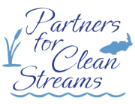 This month, we’re highlighting how marine debris travels through stormwater, creeks, and ditches, and how we can all help stem the tide. After all, since it’s a human-caused problem, that means the solutions are human-powered.
This month, we’re highlighting how marine debris travels through stormwater, creeks, and ditches, and how we can all help stem the tide. After all, since it’s a human-caused problem, that means the solutions are human-powered.
Marine debris, or waterway trash, is an ongoing issue locally and around the world. One study from the University of Rochester calculated that 22 million pounds of plastic debris potentially enter the Great Lakes every year.
At any size, from tiny plastic pellets to illegally dumped cars, marine debris poses a threat to the health of humans and wildlife. Microplastic pieces are often ingested by fish and birds. When this happens, plastic can accumulate in their stomachs, causing significant problems and potentially death. Entanglement in plastic debris is another marine debris-related wildlife mortality cause. Fishing nets, fishing lines, synthetic ropes, and plastic packaging can all act as traps for unwary aquatic life.
Like other pollutants, marine debris can hitch a ride through storm drains, ditches, and creeks. Trash travels! From tributary waterways, marine debris enters larger waterways like Swan Creek, the Ottawa River and the Maumee River. While many groups are working hard to educate and prevent marine debris, the process begins with you. There are everyday step you can take to reduce your odds of contributing to marine debris.
Check out Lake Erie Starts Here’s marine debris page for more on marine debris’ causes and its human-powered solutions!
